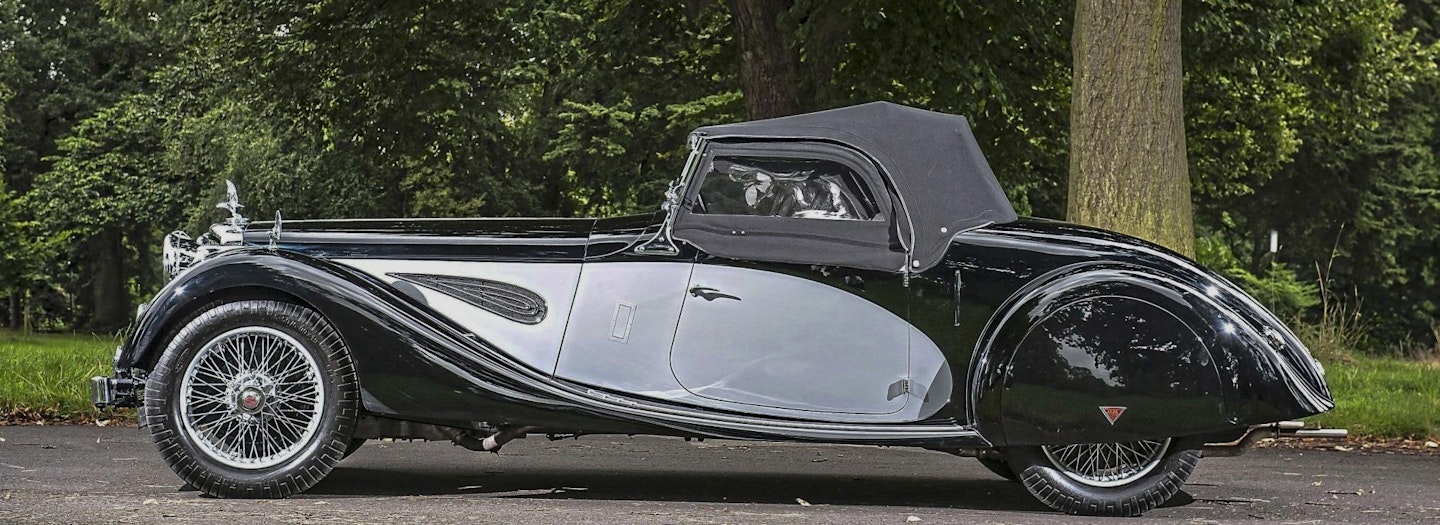Is this unique Alvis Speed 25 the finest-looking British car of the Thirties? It has a strong claim to that title, and after years of careful refinement, it’s one of the best to drive, too
Words NIGEL BOOTHMAN Photography LAURENS PARSONS

You can tell this car is something special at a glance, and the more you learn about it, the more your first impression is proved right.
It’s the only Alvis Speed 25 with this glamorous Offord ‘hidden top’ roadster bodywork. It is also the only Speed 25 built as a two-seater, not counting the various specials created in later decades. Come to that, it’s not purely a Speed 25 at all, because it’s no longer running a Speed 25 engine. The original 3.5-litre unit disappeared, possibly in occupied territory during the war, and after peace came it was fitted with a new 4.3-litre unit acquired directly from Alvis. Since then, it’s been through various adventures on both sides of the Atlantic, so it’s had something of a past.
Back in the present, we have this wonderful opportunity to drive it. The car is looked after by Fisher Restoration, which has a workshop here on the Chateau Impney estate near Droitwich Spa, Worcestershire. The car has been busy recently, traversing Europe to attend concours events and adding to the impressive mileage covered in its current long-term ownership. Back in the UK, it’s been up to Scotland for the Alvis Owner Club’s International Alvis Day at Crieff Hydro, too. It should be fit, then.

Retard the ignition with the left-hand control on the steering wheel boss, flick the ignition key over, press the starter. It catches immediately and settles to a brawny, bass-rich idle, so we can advance the ignition and leave it there. There are two other quadrant controls on the steering wheel, one for the lights and the other is a hand-throttle, beautifully set up for keeping the big overhead valve straight-six happy as it warms. Each click on the pawl makes an audible difference to the engine speed.
Into first. The clutch is gentle and takes up drive smoothly with no need for leg-trembling care, while the famous Alvis all-synchromesh gearbox slots home through second, third and top with its usual silent ease, at the end of long-ish throws of the lever. I pull out onto the Worcestershire A-roads and within a few hundred yards, it’s obvious what a successful job has been done in sorting this example. I’ve driven seven or eight Alvis Speed 25 and 4.3-litre cars, and they are always charismatic and exciting but are tricky to get 100% right. Adjustment of brakes, suspension, steering and the way they all combine with coachbuilt bodies on flexible chassis can be cruelly exposed by British road surfaces. Not so here.
It feels collected, well balanced and fast. This Alvis pulls strongly from 25mph in top gear; that is not nursing it away but accelerating hard. Even with a recommended rev limit – some belt-and-braces engine work is coming up eventually – there is a lot of fun to be had, as 60mph in top is only 2500rpm. Indeed, the Alvis is right in its happy place between 45 and 65mph in that one gear, surging away from traffic as you leave a 40mph zone. I soon find myself pulling out to pass dawdling vans without needing to change down, though a drop to third does produce an exciting exhaust growl and a roar as the big SU carburettors draw air. Any 4.3-litre Alvis with a touring body was reckoned to be a 100mph car when new, and it feels totally plausible. Yes, you’d need a long road to overcome the Thirties aerodynamics, but you’d only be turning a little more than 4000rpm at the ton.
Enjoyed your teaser? Read more from this article when you subscribe to Classic Cars today. Choose a Print + Digital subscription and you'll get instant digital access to this article and so much more.
PLUS FREE UK delivery so you'll never miss an issue again.
